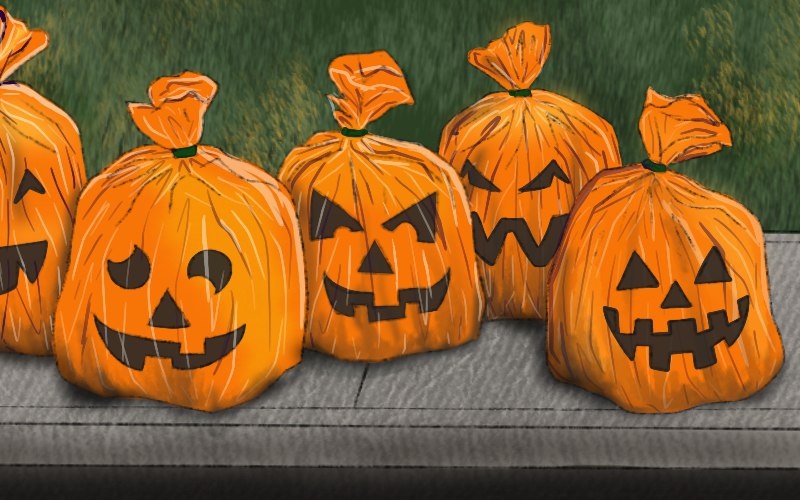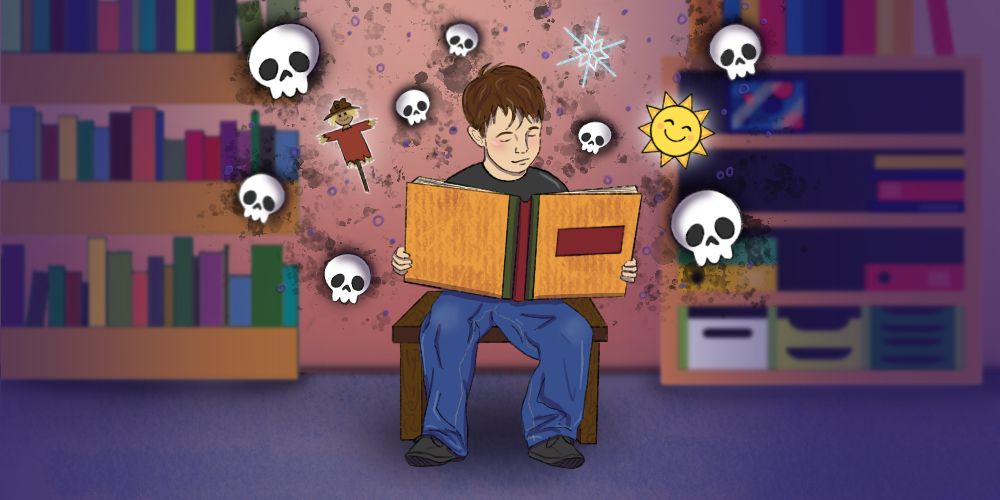Autumn fascinates thanks to its paradoxical nature, full of vibrancy and decay. The way that autumn unravels with a soft scratching in the night as the wind blows leaves across yards and sidewalks creates a potent mix of chills and nostalgia. The colorful foliage comes with the reminder that death is looming around the corner.
Autumn can be lovely at first glance, but it always leans in, whispering, “Enjoy it while it lasts.” There’s a deeper meaning in that cruel whisper, though, and it’s why autumn grants an understanding of life.
In kindergarten, my teacher kept a decorated calendar on the wall. At the end of every month, a few students would gather to design the next month’s calendar display with her. Snow for December, flowers for April, suns for June.
I never joined in. I liked keeping to myself during free time, reading one of the classroom’s many picture books. However, I did look up from time to time, and I can clearly recall spotting the teacher and my peers placing images of pumpkins and scarecrows on the calendar the day before October began. A flicker of excitement in me yielded a smile. For the first time, I understood that we could anticipate an entire time of the year. I only had a limited sense of this already; I looked forward to the weekend, sure, and I looked forward to the end of the school day, certainly, but this long-term view knocked my little brain around. You need not only look forward to getting home from school; you could look forward to a whole season, one with pumpkins, costumes, and candy.
As I am on the autism spectrum, time markers help ground me. They offer a structure to the year and thus to life. Autumn provides this in multitudes. October concludes with Halloween, November concludes with Thanksgiving, and December concludes with the end of autumn and the holiday season. There’s a clear arc to the fall, with each stop along the way containing its own identity.
That all those identities in some way deal with death imagery is either a bonus or something you try to overlook — depending on personality. For me? It’s a bonus. That will not surprise anyone who knows me now: I write horror fiction and teach a Horror Literature course. But anyone who knew that kindergartener looking at the calendar would be in a state of shock.
I was a terrified child, you see. Not anxious, that doesn’t do me justice. Terrified. Everything new was scary. Hell, even familiar things scared me. Being in home’s warmth was the best so long as it wasn’t night. Who knew what horrors, existential or physical, hid lurking in the dark?
Yet, I loved autumn even back then.
When I was in elementary school, I would play outside (often with a bat that I pretended was a Jedi’s lightsaber) while my parents raked up the dead leaves in our yard. My dad purchased garbage bags for the leaves that were orange with a jack o’lantern face on the front. When filled to the brim, they’d line our curb, ten or twelve smiling pumpkin faces. The smiles had just enough creepiness to put an edge of anxiety in me, but it was the good kind, the kind that promised a tingling story but not one that’d be too scary.

Those garbage bags were popular back then, and the thought of them brings me back to 1997, the first Halloween season I can truly remember. My aunt took me for a walk around town to look at the neighbors’ decorations. Plenty were fun, smiling scarecrows and spiders with googly eyes, while others were a little more extreme, featuring guts and bone, skeletons hung from trees, and scarecrows with eyes filled with hate. I was hurried past houses with those displays; everyone who knew me knew my timid nature. No one wanted to be responsible for one of my meltdowns.
Was I scared, though? Not that I can remember. Instead, I felt curious. Perhaps those moments foreshadowed the horror fan and horror writer I’d later become. Perhaps it also foreshadowed how the season of decay would form my relationship with death and rebirth.
These are warm autumn memories with little of the creepiness that autumn can bring and what creepiness there was, well, it was always the good kind. The kind that felt controlled. Not that type that made me feel like I was an object at the whims of a cruel universe.
That came later, in high school, a place I’ll refer to as the Overlook Hotel. I did not mesh well with its religious nature nor with its authoritarian outlook on how students should be treated. When you treat young people like they are always somehow sinful, they’ll grow up believing they deserve poor treatment. Thanks to this, summer offered a blessed escape, but the season’s final weeks would be shadowed by the looming school year. Yet, that shadow did not extend to the fall. Once autumn started at the end of September, well, things would be rolling in a positive direction. In hindsight, my mindset sounds like madness, but it went like this: autumn led to Christmas, which offered a nice break from the Overlook Hotel. Then, when I returned from that break, the school year was halfway over.
So, the further into autumn you were, the better the outlook. As the days shortened and the leaves turned brown (my block was never graced with multicolor leaves, sadly), I did not exhibit seasonal depression. No, I felt relief. The school year was moving on. Maybe there’d be an end in sight after all. Death around me was a good sign.
As an adult, autumn still holds a special place in my heart. It’s by far my favorite season (great jogging weather!) even though I’m no longer trapped in the Overlook Hotel. Is it just nostalgia? Is it the connection the season has with my favorite genre of horror?
I suspect both play a part, but there’s more.
Autumn reminds you everything comes to an end. It can be an inspiring reminder to take advantage of your current opportunities, the type of life-affirming notion your relative shares via memes on Facebook. But I don’t view autumn as a reminder to seize the day. I’ve never been much of a carpe diem person. I just don’t have that personality.
For those who suffer from mental illness, or a whole cocktail of them like yours truly, the idea that a stage of life can end is reassuring. A depressive episode or a panic attack feels endless. It can be damn near impossible to convince yourself in the moment that the pain will pass. Autumn offers us the reminder that everything in life ends at some point. It’s a promise, one that we can cling to during dark times.
It’s a promise that life ends, too. That’s not quite as pleasant, but death hangs over us from the moment we’re born. We can’t think about it all the time, it’s too much of an existential conundrum that it’d paralyze us to always have it on the mind, but we know it’s there, lurking just out of view. Autumn offers a reminder of death, yes, but it also assures us that it’s natural. You’re going to die, that’s the nature of life, there’s no escaping it. Like the once beautiful leaves, we will shrivel up and be swept away, forgotten for the most part. But we decompose and give way to new life, just like the leaves. Autumn does not offer us a personal reincarnation; instead, it reminds us that existence itself continues even if we are no longer conscious of our part in it. Death is change. Part of the process. Like autumn, there’s no way to stop its coming, but in that, we can take some solace; just as the world continues on despite autumn, the universe will continue on after we’re once more dirt and ash. Even if humanity ruins Earth with greenhouse gas admissions, the galaxy will continue, and the stars will die and be reborn. Not unlike those leaves that adorn the trees.
Perhaps that’s a blow to the ego, but it should be a relief, too. The responsibility will not always be on us. We’ll be placed into our own cosmic pumpkin garbage bags one day, and all our problems will scatter along with a cold wind. Until that day, which will hopefully be a while from now, we can take comfort in each year’s autumn, and the knowledge that things pass in time.




